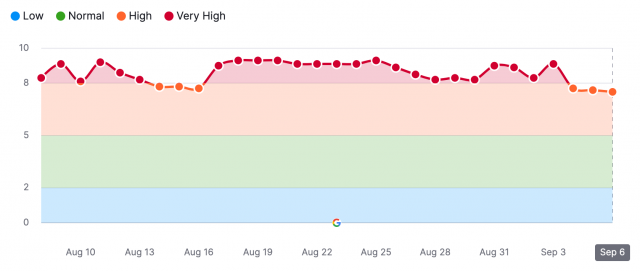In the ever-evolving world of search engine optimization (SEO), algorithm updates serve as pivotal moments that can significantly impact website rankings. Most recently, two recent algorithm updates have caught the attention of SEO experts and website owners alike: the Broad Core Algorithm Update in August 2023 and the Helpful Content Update in September 2023. Understanding these updates is crucial for maintaining a robust online presence.
What Are Algorithm Updates?
Algorithm updates are changes made to the search engine’s ranking systems to improve the quality of search results. These updates can affect various elements, from content quality to user experience. While some updates are minor, core updates can have a profound impact on website rankings.
Broad Core Algorithm Update: August 2023
The August 2023 Core Update was a significant change aimed at improving the search experience by emphasizing high-quality, people-first content. Rolled out on August 22, 2023, this update took about two weeks to fully implement. According to data providers, the update reached a peak volatility of 9.3, indicating substantial changes in website rankings.

Key Takeaways
- High-Quality Content: Google advises focusing on content that provides original information, reporting, research, or analysis.
- People-First Approach: The content should be written by experts or enthusiasts who know the topic well.
- Self-Assessment: Google offers a list of self-assessment questions to help website owners evaluate their content.
Helpful Content Update: September 2023
The September 2023 Helpful Content Update was another milestone, primarily focused on identifying signals of quality that correspond to helpful content. This update introduced changes in three key areas:
- Machine-Generated Content: Google loosened its guidance, indicating a more flexible approach.
- Third-Party Content: The update warns about hosting third-party content on subdomains.
- Recovery Guidance: New guidelines were added on how to recover if your site is affected by this update.
The September 2023 helpful content update is rolling out with an improved classifier. It will take about two weeks to complete. We'll update our ranking release history page when the rollout is complete: https://t.co/hgjEkfpbA2
— Google Search Central (@googlesearchc) September 14, 2023
What Does Hosting Content on a Subdomain Look Like?
The biggest impact of this ties back to how it impacted third-party content hosted on subdomains. A subdomain is a separate section of your main website designed to organize and navigate to different areas of your site easily. For example, if your primary domain is www.example.com, a subdomain might look like blog.example.com or shop.example.com. Hosting third-party content on a subdomain means allowing external content, which you may not have control over, to reside on a specific part of your website. This practice is common among news media websites, affiliate marketers, and online platforms that offer various services.
How is it Different from Content on the Primary Domain?
Control and Management: Content on your primary domain is usually under your direct control, adhering to your quality standards and guidelines. In contrast, third-party content on subdomains might need to meet these criteria, as external entities often create and manage it.
- SEO Impact: Search engines like Google treat subdomains as separate entities for ranking purposes. Therefore, low-quality third-party content on a subdomain can negatively affect the SEO of the subdomain without directly impacting the primary domain. However, the overall reputation of your main domain could still be at risk.
- User Experience: Content on your primary domain is generally cohesive and offers a consistent user experience. Third-party content can vary in quality and relevance, potentially leading to a disjointed user experience.
- Monetization and Partnerships: Hosting third-party content is often part of a monetization strategy or a partnership agreement. While this can be lucrative, it comes with the risk of diluting your brand’s message and quality.
Why the Warning in the Helpful Content Update?
The September 2023 Helpful Content Update warns about hosting third-party content on subdomains. The reason for this warning is that Google’s updated algorithm is more stringent about the quality of content. If a subdomain hosts low-quality third-party content, it could significantly impact the search rankings of that subdomain. Google’s new guidelines suggest that if you host third-party content, you should consider blocking it from being indexed by Google if it doesn’t meet quality standards.
What Constitutes Helpful Content?
In Google’s eyes, helpful content is:
- Quality-Driven: The content should offer valuable insights or solutions.
- User-Centric: It should be written from the user’s perspective, providing a comprehensive answer to their queries.
- Trustworthy: The content should be reliable, with clear sourcing and evidence to support claims.
How to Recover from an Algorithm Update
Recovery from an algorithm update involves identifying the areas impacted and taking corrective measures. Here are some steps to consider:
- Audit Your Content: Evaluate your content based on Google’s guidelines and make necessary adjustments.
- Monitor Traffic: Use analytics tools to track changes in traffic and identify affected pages.
- Consult Experts: Seek advice from SEO professionals for a more in-depth analysis and tailored solutions.
Trust ASTOUNDZ for Your SEO Needs
Navigating the complexities of algorithm updates can be challenging. That’s where ASTOUNDZ comes in. As a trustworthy SEO agency, we ensure your website is built on a solid foundation. If your site does get hit by an update, our team of experts goes to work to help you recover. With ASTOUNDZ, you’re guaranteed a partner committed to your online success.






